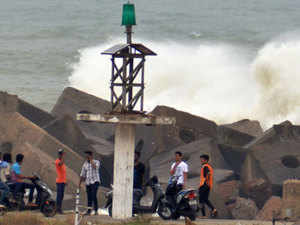
BHUBANESWAR: Cyclone 'Fani', which pulverized parts of coastal Odisha on May 3, had the longest life span among tropical cyclones in the Bay of Bengal, an eminent meteorologist said Tuesday.
"The elongated time period of the extremely severe cyclonic storm continued for eleven days in the sea and land put together and had the longest life span ever observed in the Bay of Bengal," said S C Sahu, former Director of the Meteorological Centre here.
The peculiarity of this strong cyclonic storm was the persistence of its intensity till it crossed the coast and it did not weaken following interaction with land after crossing the coast close to Brahmagiri in Puri district, he said.
Besides, it did not cause extreme heavy rainfall in Odisha as was anticipated, Sahu said, adding that the storm's surge in height, as reported by the locals at Satapada, was about ten feet while the wind speed was more than 200 km per hour.
The cyclonic storm, which started as a low pressure near the equator on April 24, took about two hours to cross the coast after landfall and then headed northwards towards Bhubaneswar and nearby areas.
Odisha's capital city was within the eye of the cyclone, the diameter of which was about 28 km.
There was a lull in the cyclone for about 30 minutes after which the wind direction as well as the speed changed. The wind speed increased as the eye crossed over to land due to a combination of wind velocity and downdrafts caused by thunderstorm over Bhubaneswar at that time, he said.
The cyclone maintained its intensity till it reached Bhubaneswar and then hanged direction to move in a northeastward direction towards Mayurbhanj.
The devastation wrought by 'Fani' over land was mainly due to high wind speed and fast movement. But it would have caused greater devastation had it remained stationary or moved at low speed on land for some time, said Sahu, who is now the Director of Centre for Environment and Climate (CEC) of a private university here.
After weakening of the system, the temperature in Odisha's interior districts rose suddenly and it was likely to rise further May 17 onwards, touching 45 degrees Celsius in most locations in western and interior districts. The situation is likely to continue for about a week, he said.
Tropical cyclones are known by various names in different parts of the world, such as Hurricane in north Atlantic Ocean and eastern North Pacific Ocean, Typhoon in western North Pacific Ocean around Philippines, Japan and China, and Tropical Cyclones in western South Pacific Ocean and Indian Ocean.
"The elongated time period of the extremely severe cyclonic storm continued for eleven days in the sea and land put together and had the longest life span ever observed in the Bay of Bengal," said S C Sahu, former Director of the Meteorological Centre here.
The peculiarity of this strong cyclonic storm was the persistence of its intensity till it crossed the coast and it did not weaken following interaction with land after crossing the coast close to Brahmagiri in Puri district, he said.
Besides, it did not cause extreme heavy rainfall in Odisha as was anticipated, Sahu said, adding that the storm's surge in height, as reported by the locals at Satapada, was about ten feet while the wind speed was more than 200 km per hour.
The cyclonic storm, which started as a low pressure near the equator on April 24, took about two hours to cross the coast after landfall and then headed northwards towards Bhubaneswar and nearby areas.
Odisha's capital city was within the eye of the cyclone, the diameter of which was about 28 km.
There was a lull in the cyclone for about 30 minutes after which the wind direction as well as the speed changed. The wind speed increased as the eye crossed over to land due to a combination of wind velocity and downdrafts caused by thunderstorm over Bhubaneswar at that time, he said.
The cyclone maintained its intensity till it reached Bhubaneswar and then hanged direction to move in a northeastward direction towards Mayurbhanj.
The devastation wrought by 'Fani' over land was mainly due to high wind speed and fast movement. But it would have caused greater devastation had it remained stationary or moved at low speed on land for some time, said Sahu, who is now the Director of Centre for Environment and Climate (CEC) of a private university here.
After weakening of the system, the temperature in Odisha's interior districts rose suddenly and it was likely to rise further May 17 onwards, touching 45 degrees Celsius in most locations in western and interior districts. The situation is likely to continue for about a week, he said.
Tropical cyclones are known by various names in different parts of the world, such as Hurricane in north Atlantic Ocean and eastern North Pacific Ocean, Typhoon in western North Pacific Ocean around Philippines, Japan and China, and Tropical Cyclones in western South Pacific Ocean and Indian Ocean.
Read More News on
(Catch all the Business News, Breaking News, Budget 2024 News, Budget 2024 Live Coverage, Events and Latest News Updates on The Economic Times.)
...moreDownload The Economic Times News App to get Daily Market Updates & Live Business News.
Subscribe to The Economic Times Prime and read the ET ePaper online.
Read More News on
(Catch all the Business News, Breaking News, Budget 2024 News, Budget 2024 Live Coverage, Events and Latest News Updates on The Economic Times.)
...moreDownload The Economic Times News App to get Daily Market Updates & Live Business News.
Subscribe to The Economic Times Prime and read the ET ePaper online.





